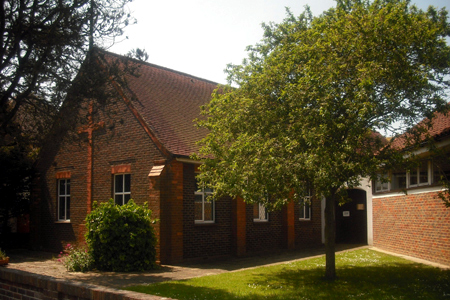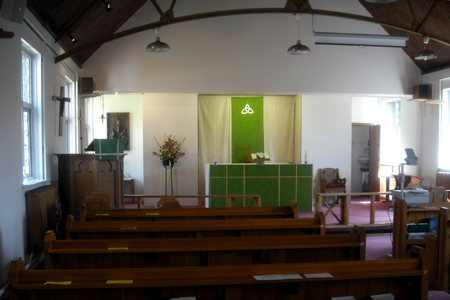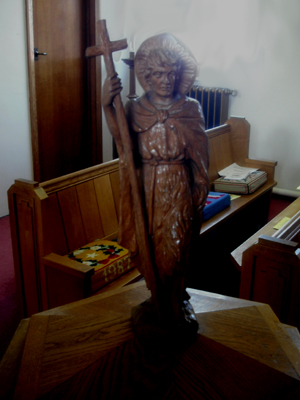| |
 |
 |
 |
| Comment on this report, or find other reports. |
 |
| Our Mystery Worshippers are volunteers who warm church pews for us around the world. If you'd like to become a Mystery Worshipper, start here. |
 |
| Find out how to reproduce this report in your church magazine or website. |
|
|
| 3028: St Laurence, Goring-by-Sea, England |
 |
 |
 |
Mystery Worshipper: Teutonic Knight.
The church: St Laurence, Goring-by-Sea, West Sussex, England.
Denomination: Church of England, Diocese of Chichester.
The building: It was constructed in 1936 on land donated by a local farmer to serve the growing seaside parish. The church was dedicated to this particular saint because an annual St Laurence Fair can be traced back to 1297 in the area. The utilitarian red-brick building is an unassuming but not unattractive plain structure that owes its design more to bungalows or army barracks than ecclesiastical architecture. If it wasn't for a large cross in lighter brick in the wall, you would struggle to recognise it as a church building. Inside, it is surprisingly well-ordered contrary to what the outside would suggest, a bit like a modern monastic chapel. To the left of the altar is a little oratory alcove with a relief of Christ crucified flanked by Mary and St John. On the south wall hangs a modern fabric picture of what I assume to be St Laurence the Deacon, although he seems to be wearing a pallium. At the west end is a beautifully carved wooden font. The side panels depict the pilgrim's scallop shell besides other biblical motifs, and the finial of the lid is in the form of a splendidly rugged John the Baptist wearing his camel hair coat. Another beautiful carving of the Holy Spirit appears on the west wall above the Book of Remembrance. Adjacent, but connected through the kitchen area, is the church hall, another red brick building that appears to be of later vintage but in keeping with the style. Slightly unusual about this building is a star in the gable that looks rather too much like a pentagram, albeit with a cross in the centre.
The church: They are a daughter church of St Mary's just over a mile away in the parish of Goring. They have the usual church and fellowship groups, but from the beginning of this year have stepped out into the uncharted waters of a new-style monthly family service. This usually involves lots of Rainbows, Brownies and Guides who are attached to the church and meet in the church hall. There was ample evidence of their activities in the displays on the walls. The parish have mission partners overseas, and have decided to support various missionary groups and other charities with prayer and money on a monthly basis. They also team up with another parish from nearby Brighton for parish pilgrimage holidays abroad.
The neighbourhood: Goring-by-Sea (not to be confused with Goring-on-Thames in Oxfordshire) is a neighbourhood of Worthing, a large seaside town in West Sussex. The sand and shingle beach is popular with watersport and kitesurfing enthusiasts and is where Pete Townshend recorded the beach sounds for The Who's album Quadrophenia. The church is situated in a residential area 500 yards from the seafront. The spire of St Mary's can be espied from here. The street on which the church was built now leads to a very swish yacht club. The main shopping street is within easy walking distance, as is a leisure centre, schools, and the railway station. The Inland Revenue (tax) office is also within the parish. (Well, Jesus welcomed tax collectors, didn't he?)
The cast: The Revd George Butler, vicar, assisted by a server, a young man whose name was not given. The priest wore a cassock with pellegrina, over which he donned a rather ancient looking yellowing alb with immensely wide sleeves, and a chasuble of a sickly shade of dark green of a certain vintage.
The date & time: Sunday, 29 May 2016, 11.00am – although they start off this format of service informally half an hour early in the adjacent hall with "fun, friendship and fellowship" – drinks and biscuits, fun activities for children and chat for adults.
What was the name of the service?
Family Service with Communion.
How full was the building?
There were only about ten people there this morning at the "fun, friendship and fellowship," as it was school holidays and families were away and uniformed organisations at camp. I was assured the hall is usually teeming with young people (up to 60) who would do preparatory work for inclusion in the service. They would normally do the readings and intercessions, and act out the gospel story. When we repaired to the church it was pleasantly full, around 40 people who filled the available space nicely, though in typical Anglican fashion the majority gathered in the rear half. The music group took up quite a bit of space in the middle.
Did anyone welcome you personally?
In the hall, I was immediately spotted as a visitor and engaged in friendly conversation by stalwarts of the church. In the church itself I was alone in my pew. I probably sat too far forward – there was life at the back.
Was your pew comfortable?
Standard modern-ish wooden pews with compartments for books in front and embroidered hassocks underneath. There were also padded seat tapestries, many of those embroidered with the logo of the Girl Guides. My kneeler was embroidered with a design for HM the Queen's 60th birthday – dated almost to the day 30 years previously.
How would you describe the pre-service
atmosphere?
Chatty, and I almost missed the entrance of the priest.
What were the exact opening words of the
service?
"Good morning, and we sing our worship: 'Father, hear the prayer we offer.'" This came after the microphone started working, so there may have been something before.
What books did the congregation use during the
service?
House-produced orders of service and the notice sheet had been placed in the pews along with a hymn sheet. The hymns were also projected onto a drop-down screen via an overhead projector (yes, really, in 2016!). In the book compartments were Complete Mission Praise (words edition), rather tatty prayer-book size copies of Hymns Ancient & Modern Revised (again, words edition), and The Holy Bible, New Revised Standard Version.
What musical instruments were played?
Keyboard, three (or four?) acoustic guitars, all played by mature people.
Did anything distract you?
When the priest walked in from the vestry, we all stood and waited in silence – and waited – while he sorted out his clip-on mike and mouthed something to someone at the front.

Was the worship stiff-upper-lip, happy clappy, or
what?
Despite the vicar wearing a pellegrina over his cassock, which marks him out as a "very high" Anglo-Catholic, I was surprised at how upbeat, modern, informally formal and relaxed it all was. They are using the latest eucharistic prayer, which was conceived especially with children in mind and was only authorised by general synod a couple of years ago. This church is the only place where I have heard this prayer used to good effect in the overall service structure. There was nothing forced about it, no awkward silences or missed cues for the congregational responses, and it was neatly choreographed by the vicar to be said "antiphonally." Even better, the whole prayer was printed in the order of service and everybody could follow it.
Exactly how long was the sermon?
15 minutes.
On a scale of 1-10, how good was the preacher?
8 – The vicar spoke without notes. His delivery was peppered with amusing snippets in a pleasant manner and he was smiling throughout. Having started off with a comment on long sermons, he became a bit repetitive after ten minutes when the amusing bits stopped, and I was beginning to look at my watch. He came to a finish when the point had been made several times.
In a nutshell, what was the sermon
about?
He started by reminiscing about his days as a choirboy when the shortest sermons were at least 20 minutes long, and a sermon timer hourglass, which had to be turned at least once, was fixed to the wall. Such long sermons apparently were not unpopular with choirboys because they could read books out of sight behind the choir stalls, or count the number of little squares in the windows, or (best of all) sit rather than stand for long periods. It is not surprising, then, that a recent national church survey showed that even church people have a very limited knowledge of the Bible, and more than 50 per cent do not read the Bible at all outside of Sunday worship. We need to know the Bible to realise that the story of God's dealings with his people did not end with the gospel story, or the death of the last of the apostles, but continues with us. We must recognise who and what we are in relation to Jesus. Here's a challenge: write your own version of the gospel. How has Jesus worked in your life to bring you to where you are? How would you write your part in this amazing story? What do you contribute to the gospel? We are part of the good news as the story continues.
Which part of the service was like being in
heaven?
This was the most upbeat service I have attended for a long time. Even though there were only three pre-school children and one baby present on this occasion, this is clearly a format that works for everyone here. It was lovely to see a music group that consisted of classical or folk guitarists of mature years rather than pop musicians. It was also great to see that the priest was totally unfazed by the continuing noisy whimpering of a tiny baby and told the parents not to worry when they were getting quite embarrassed. It all made for a very friendly and inclusive atmosphere.
And which part was like being in... er... the other place?
I struggle to put anything here (a first!), but it was annoying that the ancient overhead projector cut out – I think the bulb blew – when it should have been displaying the hymns. However, as the hymn books were in the pews, people did not remain voiceless if they could locate the right number.
What happened when you hung around after the service looking lost?
I wandered around the church inspecting the beautiful font and taking some pictures. Though I spoke to a few people, they were mostly catching up with each others' news. Even so, they seemed a friendly bunch.
How would you describe the after-service
coffee?
We had our coffee beforehand at the "fun, friendship and fellowship."
How would you feel about making this church your regular (where 10 = ecstatic, 0 = terminal)?
9 – When I first saw the church building I thought I would dislike the whole experience. How wrong I was! Meeting people before the service in the hall was good – it made me feel less like an outsider, having established some form of relationship. I would love to experience the "full works" here, when all the children are taking an active part, leading the readings and prayers, and acting out the gospel. But perhaps even better is that this format works just as well without children doing their bit. This surely is an achievement. I will come again.

Did the service make you feel glad to be a
Christian?
I am now starting my homework as instructed: I am in that story, and yes, I am glad that I am.
What one thing will you remember about all this in seven days' time?
The simple beauty of the church "in an army shack." |
|
|
 |
 |
 |
| We rely on voluntary donations to stay online. If you're a regular visitor to Ship of Fools, please consider supporting us. |
 |
 |
 |
| The Mystery Pilgrim |
 |
| One of our most seasoned reporters makes the Camino pilgrimage to Santiago de Compostela in Spain. Read here. |
 |
 |
 |
| London churches |
 |
| Read reports from 70 London churches, visited by a small army of Mystery Worshippers on one single Sunday. Read here. |
| |
|
|
|
|


